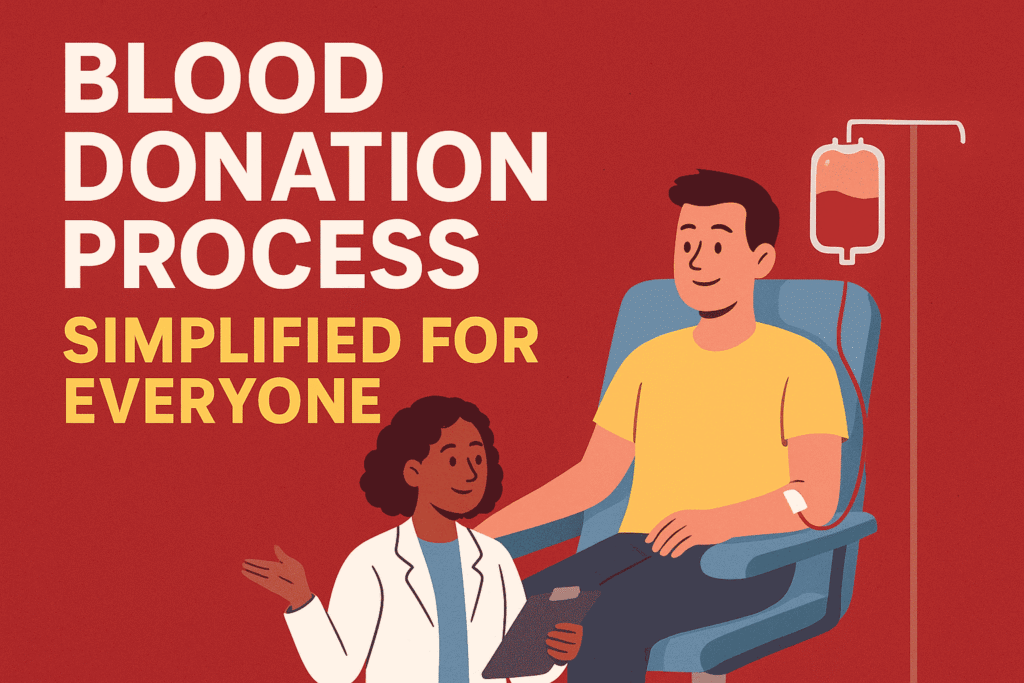Blood donation is one of the simplest yet most impactful ways to save lives. Every few seconds, someone in a hospital needs blood for surgery, accident recovery, cancer treatment, or medical emergencies. Yet, despite this urgent need, there’s always a shortage of available blood. Understanding how the blood donation process works can help reduce hesitation and encourage more people to donate regularly.
Step 1: Registration and Basic Screening
The blood donation process begins with a quick registration. You’ll be asked to fill in some personal details like your name, age, and contact information. A valid ID proof is usually required.
Once registered, a basic health screening takes place to ensure you’re eligible to donate. Medical professionals will:
-
Check your hemoglobin level to confirm you’re not anemic.
-
Measure your blood pressure, pulse, and temperature.
-
Ask a few questions about your medical history, recent medications, or travel history to ensure safety for both donor and recipient.
This step ensures that blood donation is safe for everyone involved.
Step 2: The Blood Donation
After the screening, you’ll be guided to a comfortable chair or bed for the donation. The nurse or technician will clean your arm with an antiseptic and insert a sterile needle into a vein — usually in your inner elbow.
The process typically takes 8 to 10 minutes, during which about 350–450 ml of blood is collected (depending on your body weight and donation type). The equipment used is completely sterile and discarded after one use, eliminating any risk of infection.
While donating, you can relax, listen to music, or simply enjoy the feeling that you’re doing something meaningful.
Step 3: Post-Donation Care
Once the donation is complete, the needle is removed and a small bandage is applied to your arm. You’ll be asked to rest for about 5–10 minutes and offered snacks or juice to help replenish your energy.
Here are a few quick care tips after donating blood:
-
Stay hydrated: Drink plenty of water throughout the day.
-
Avoid heavy exercise: Give your body time to recover for 24 hours.
-
Eat iron-rich foods: Include spinach, lentils, and fruits in your diet.
Most people feel perfectly fine after donating. In fact, your body starts regenerating the lost blood within 24–48 hours, and the red blood cells are completely replenished in about a month.
Step 4: What Happens to Your Donated Blood
Your donated blood goes through a thorough testing and separation process before it reaches a patient. It’s tested for:
-
Blood type (A, B, AB, or O)
-
Infectious diseases (like Hepatitis, HIV, Malaria, etc.)
Once cleared, the blood is separated into three main components:
-
Red Blood Cells (RBCs) – For treating anemia and surgical needs.
-
Plasma – Used for clotting disorders and burn victims.
-
Platelets – Vital for cancer and dengue patients.
This means one donation can help up to three people — a true multiplier of hope and life.
Why Donating Blood Matters
Blood donation isn’t just a good deed — it’s a necessity. Hospitals rely on voluntary donors to ensure a consistent blood supply. Unfortunately, many patients suffer simply because compatible blood isn’t available at the right time.
Here’s why donating blood is so important:
-
Every 2 seconds, someone in India needs blood.
-
Only 1% of the population donates regularly.
-
A single unit of blood can save multiple lives.
When you donate blood, you’re not only saving lives but also promoting your own health. Regular donors often have improved iron regulation and reduced risk of certain heart diseases.
Make a Difference — Donate Blood
Blood donation is a small act with a huge impact. Whether you’re a first-time donor or a regular contributor, every effort counts toward building a healthier, more compassionate world.
When you give blood, you’re:
-
Giving hope to families in distress.
-
Strengthening community healthcare.
-
Inspiring others to follow your example.
Let’s normalize blood donation as part of our social responsibility. You don’t need to be a doctor to save a life — just a donor with a kind heart.
Final Thoughts
Donating blood is safe, quick, and deeply rewarding. It’s a habit that builds compassion and strengthens the fabric of humanity. By understanding the process, more people can overcome hesitation and take part in this life-saving mission.
Next time you see a blood donation camp or get an opportunity to help, remember — your single donation could be someone’s second chance at life.

